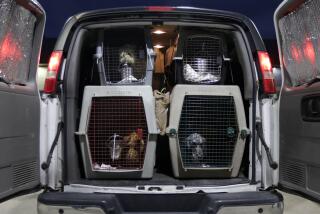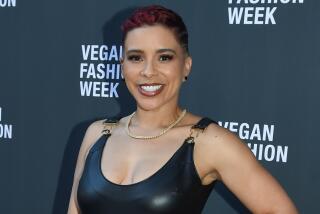Use of Sperm Banks Is Going to the Dogs
- Share via
Like other fertility doctors, Priscilla Stockner proudly shows visitors to her Escondido clinic photos of offspring she has helped bring into the world.
There is, for instance, Sara Lee, a pup that got her moniker by being the first Corgi champ conceived with sperm from the freezer.
You’re at the Canine Cryobank and Animal Fertility Clinic, where, through the wonders of modern science, blue-blooded dogs and cats are matched biologically with others of impeccable lineage.
This particular day, a schnauzer bitch with great genes--and bad morning sickness--is in for an ultrasound. The owner, Pat Bott of Lakeside, suspects that the dog has been compromised by her Bedlington terrier, Calvin. Stockner confirms her worst fears.
Bott grimaces: “Damn Calvin!” She books the schnauzer for an abortion, knowing “there is no market for Bedlington schnauzers. Some people let their bitch have puppies and then they stand in front of the Alpha Beta giving them away. I won’t do that.”
Four injections will terminate the pregnancy. The fee: $350.
It might surprise the owner of the average Fido or Felix to learn that, in a world overpopulated with dogs and cats, there is a need for a fertility clinic. But most of Stockner’s patients are not average animals.
The Canine Cryobank has sperm-banked sled dogs owned by Susan Butcher, four-time winner of Alaska’s Iditarod race. Chevy Chase’s golden retriever was brought in for artificial insemination. Fat Albert, Bill Cosby’s schnauzer, has been assured of immortality of a sort.
(Knowing that the stress of the show ring, and of air travel, can play havoc with champion dogs’ psyches and sex drives, the American Kennel Club now accepts for registration animals conceived artificially.)
But even some garden-variety pets have their semen stored at the clinic (at a cost of $350 for collection, evaluation and first year’s storage, $75 a year thereafter). Stockner’s partner, Carol Scott Bardwick, mentions a client in his 60s who had his terrier-mix sperm-banked. Antecedents of that dog had been his pets since the man was a child, and he hoped that someday his terrier would carry on the line.
Sometimes, a keen sense of commercial possibilities motivates an owner.
Dreyfuss, the appealing canine star of TV’s “Empty Nest,” has his sperm banked. And a St. Bernard was artificially inseminated with sperm from Dreyfuss’ father, a golden retriever, in hopes of producing baby Dreyfusses. Two of a litter of seven were look-alikes.
Lassie, alas, would not be a likely candidate for sperm-banking. “You can get collies and train them,” Bardwick explains. You have to clone a Dreyfuss.
The Chilling Fear of a Perennial Outsider
The Sisterhood Bookstore in Westwood marked its 20th birthday by inviting feminist writers to read from their works. Among them was Los Angeles lawyer Victoria King, who grew up in the Civil Rights-era South, graduated summa cum laude from Fordham University and spent 15 years as an electrician before entering UCLA law school. Her book is “Manhandled: Black Females”:
“On my first trip home from college, I saw how limited my world truly was. For the first time I saw my world through the eyes of an outsider and realized how precarious a position I occupied relative to the world around me. . . .
“My first trip home from college was also memorable in that my ne’er-do-well uncle murdered both my favorite aunt (his wife) and my grandmother. . . . After 20 years of enduring hard times and my uncle’s drinking, gambling and other women, my desperate aunt had decided to leave her husband. She was quite sick, and my grandparents helped her find an apartment so that she could heal in peace. I had never seen her look so poorly.
“My grandmother was taking my aunt to the doctor when my uncle drove by in his hopped-up car and shotgunned both of them to death in full view of my cousin (their son), who was opening the car door for his mother. So much of my grandmother’s head was blown away that her casket could not be opened at the funeral. My grown cousin, who at 6 feet, 4 inches was the most gentle giant I have ever known, could only cry, “Daddy, why?” as he stood soaked in blood and fragmented body tissue and watched his mother bleed to death on the sidewalk. . . .
“I was 19 years old, and for the first time in my life I sensed how estranged we really were from white America. There was no public outcry at the deaths of my grandmother and aunt. Their deaths were business as usual.
“Even now, 20 years and six states later, I sometimes wake up in the middle of the night sweating and panic-stricken, not grieving for my long-dead grandmother and aunt, but fearful that there is no safe harbor for women like me, castoffs in a white society. The nightmare is always the same. Something huge and hideous that sucks the very oxygen from the air is chasing me. No matter how fast I run, which way I turn or where I try to hide, the horror is always one step behind, breathing down my neck. . . . I never look behind me in these dreams because I know that always I am a hair’s breadth from disaster. . . .
More to Read
Sign up for Essential California
The most important California stories and recommendations in your inbox every morning.
You may occasionally receive promotional content from the Los Angeles Times.










